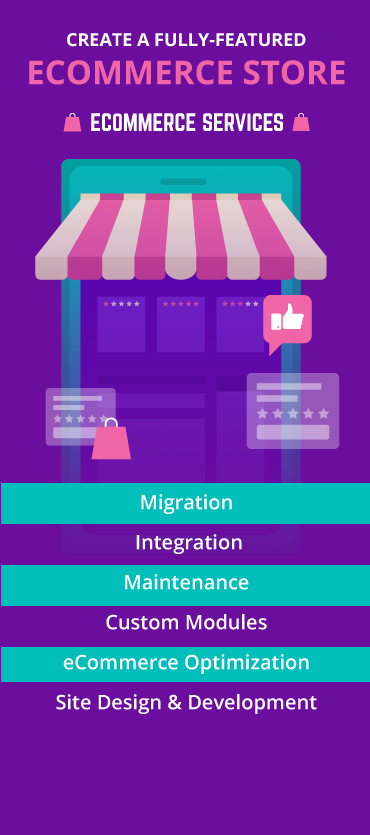In a world where technology is advancing at an unprecedented pace, eCommerce has emerged as a game-changer.
With just a few clicks, consumers can browse countless online stores, compare prices, read reviews, and buy at will.
However, this convenience of online shopping has also enhanced customers’ expectations exponentially.
To stay competitive, businesses need to keep evolving as per the changing needs and market progression.
And for this, they need to embrace emerging eCommerce trends.
In this blog post, you’ll discover the leading eCommerce trends that are not only defining the industry’s present but will also shape its future for unprecedented growth.
From Virtual to Reality: The Transformation of eCommerce Experiences

The emerging trends in eCommerce are set to reimagine the future of online shopping by offering more personalized, immersive, and convenient experiences.
Let’s take a look at them:
- AI-Powered Personalized Shopping Experience
Artificial intelligence (AI) is revolutionizing eCommerce by enabling highly personalized shopping experiences. AI algorithms analyze customer data, including browsing behavior, purchase history, and preferences, to provide tailored product recommendations.
This personalization extends to customized offers, targeted marketing campaigns, and dynamic pricing as well. AI-powered chatbots and virtual shopping assistants also assist customers in finding products, answering queries, and offering personalized assistance throughout their shopping journey.
- Augmented Reality (AR) and Virtual Reality (VR) Integration
Augmented reality and virtual reality technologies are being integrated into eCommerce platforms, transforming the way customers interact with products. AR allows customers to visualize products in their own environments, enabling them to virtually try on clothing, test furniture placement, or see how a product would look in their homes.
VR creates immersive experiences, such as virtual showrooms or virtual tours of products. This helps businesses to enhance customer engagement, reduce uncertainty in online purchases, and increase conversion rates.
- Rise of Voice Commerce
Voice commerce is gaining traction as voice assistants like Amazon’s Alexa, Google Assistant, and Apple’s Siri become mainstream. Customers are using voice commands to search for products, place orders, and track deliveries.
Retailers are optimizing their platforms for voice search and integrating with smart speakers that allow customers to make purchases hands-free. This offers convenience, accessibility, and ease of use to consumers for online shopping.
- Blockchain and Cryptocurrency Adoption
Blockchain enables secure and tamper-proof record-keeping, which is crucial for supply chain management. The adoption of blockchain technology in eCommerce helps businesses secure their transactions, combat counterfeit products, and improve customer trust. Additionally, the integration of cryptocurrencies like Bitcoin and Ethereum offers an alternative payment method with faster transactions and reduced fees.
- Social Commerce Expansion
Social media platforms have become influential channels for eCommerce. Social commerce integrates shopping directly into social media platforms, enabling users to discover, share, and purchase products without leaving the app. Features like “buy” buttons, shoppable posts, and live shopping experiences facilitate seamless transactions and capitalize on the social influence of platforms like Instagram, Facebook, and Pinterest.
- Sustainability and Ethical Shopping
Customers are increasingly prioritizing sustainability and ethical practices in their purchasing decisions. eCommerce businesses are responding by promoting eco-friendly and ethically sourced products. They are implementing sustainable packaging, highlighting product certifications (e.g., organic, fair trade), and communicating the brand’s social and environmental initiatives. Using transparent supply chains and responsible sourcing and manufacturing processes, they are also building trust and loyalty among conscious consumers.
- Drone and Autonomous Delivery
Delivery methods are evolving to meet customer expectations for faster and more efficient shipping. Drones are being utilized for small, lightweight deliveries, particularly in urban areas, to expedite order fulfillment and reduce costs. Autonomous vehicles, including robots and self-driving vehicles, are also being explored for last-mile delivery, enhancing efficiency and minimizing human error. These advancements in delivery technology aim to provide quicker and more flexible delivery options to customers.
- Mobile Commerce Dominance
Mobile devices continue to dominate eCommerce, with a significant portion of online purchases made through smartphones and tablets. Hence, retailers are prioritizing mobile optimization by ensuring responsive design, user-friendly interfaces, and fast-loading pages.
Mobile apps offer personalized experiences and push notifications that enhance user engagement and conversion opportunities. The rise of mobile wallets and biometric authentication has further boosted mCommerce by simplifying the checkout process.
- Hyper-Personalization and Customer Engagement
Consumers, nowadays, expect hyper-personalized experiences at every touchpoint that cater to their unique preferences. For this, businesses are investing in eCommerce platforms that leverage advanced analytics, AI, and machine learning to understand customer shopping behavior.
By analyzing customer data, such as browsing behavior, purchase history, and demographic information, they provide individualized product recommendations, targeted marketing campaigns, and personalized content. Interactive features, such as quizzes, product visualization, and virtual try-ons, help enhance customer engagement and foster a deeper connection with the brand.
Wrapping Up
The unstoppable growth of the eCommerce landscape holds a promising future for both businesses and consumers. By embracing these emerging trends, you can solidify customer relationships, foster loyalty, and maximize sales in the digital realm.











